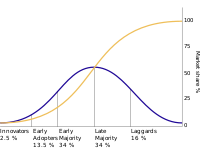
Photo from wikipedia
ABSTRACT In order to realise the potential innovation gains of similarity or complementarity in M&As, the resources and operations of the combined firm need to be reorganised and integrated. This… Click to show full abstract
ABSTRACT In order to realise the potential innovation gains of similarity or complementarity in M&As, the resources and operations of the combined firm need to be reorganised and integrated. This paper aims to analyse the mediating effect of integration decisions (integration and target autonomy) in the relationship between technology relatedness (technology similarity, technology complementarity, and their interaction effect) and technology innovation in Chinese technology-sourcing overseas M&As. The results of the empirical analysis show that besides the direct positive effect, technology complementarity has an indirect positive effect on innovation performance, because it leads to high levels of both integration and target autonomy, which facilitate the achievement of economy of scope and synergy effect. However, technology similarity may impede innovation directly and indirectly, because it leads to a high level of integration and a low level of target autonomy, and the latter will disrupt the innovation efficiency of the target. When technology similarity and technology complementarity coexist, technology complementarity can moderate both the impact of technology similarity on integration degree, and the impact of technology similarity on target autonomy. The study results add to our knowledge of integration decisions and technology innovation in M&As, and provide some implication for practitioners.
Journal Title: Asian Journal of Technology Innovation
Year Published: 2020
Link to full text (if available)
Share on Social Media: Sign Up to like & get
recommendations!